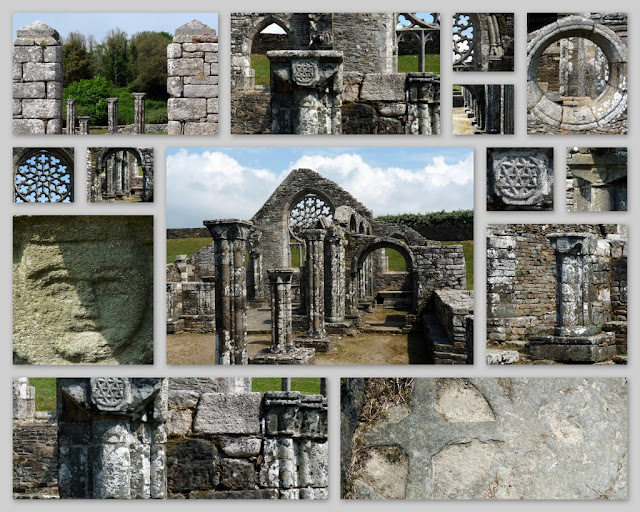On the cliffs there were flowers. There was thrift.
I like thrift. The flower, that is. I generally approve and practise the virtue too, I think. But then I remember the bit in
The Enchanted April:
Mrs. Wilkins's clothes were what her husband, urging her to save, called modest and becoming, and her acquaintance to each other, when they spoke of her at all, which was seldom for she was very negligible, called a perfect sight.
Mr. Wilkins, a solicitor, encouraged thrift, except that branch of it which got into his food. He did not call that thrift, he called it bad housekeeping. But for the thrift which, like moth, penetrated into Mrs. Wilkins's clothes and spoilt them, he had much praise.
which makes me look a little askance at thrift.
Not at the flower, however. I assume the flower was named after the virtue, not the other way around.
There was mallow,
the one above was hanging over the cliff edge, so it is in part the reflected light of the sea which passes through the petals,
and this picture I kept trying to throw out because the flower was out of focus and the leaves in, but something stayed my hand. Who says it's the flower that matters?
The blue-mauve flower with the glaucous fuzzy leaves below was everywhere, including, I think, in some cultivated versions.
I don't know what it is, and haven't got around to finding out, or indeed what that lovable little fluffy grass is called either. Identification of grasses and sedges is an an anorakism just waiting for me to acquire it, no doubt.
However, I did check out the blue butterflies, which seemed to be as tiny, holographic chips of the overwhelming blue of sea and sky.
They seemed extraordinarily blue, and consulting the book, which is illustrated only with paintings (very lovely ones, but never really so accurate), I badly wanted them to be Adonis Bllues, for the mythological hyperbole of the name, and their claim to be the bluest of all the blue butterflies in Europe. But taxonomic discipline compelled me to go to the internet, where the ever-excellent
Steven Cheshire's British Butterflies affirmed that they were mere Common Blues. However I was consoled to see that as such, their Latin name is
polyommatus icarus, while Adonis only gets to be a p.bellargus, which has less myth and magic.
There were Hottentot fig flowers,
this one had a visitor. And there was a swallowtail butterfly.

But I couldn't capture it. They are the most archetypal bright elusive butterflies, eye-catching and recognisable from a long way off by their shape and size and dipping, whimsical flight pattern, but tricksy and unpredictable, waiting until just before the camera finds its focus to take off sharpish. Fortunately, this one chose to pose on a valerian flower further down the road. In fact one of its swallowtails is broken, odd really, to have such a fragile, vulnerable, apparently useless appendage at all, but that's what makes them swallowtails, so it's just as well they do*. One of the blue butterflies has a broken segment too, I notice. Butterflies are very much like animate flowers. They blossom just for long enough to seed themselves then fade and crumble and fall away, sometimes quickly, sometimes they are quite enduring, but individuals seem to have no powers of self-renewal or repair. Then, though, they might reappear later on in a second, remontant burst of flowering. It's just an impression, though, a whimsical comparison, I'm no naturalist.
Some years we get quite a lot of swallowtails hereabouts, others hardly any. This year they seem quite common, I even saw one in the supermarket car park the other day. It was Ecomarché, too, not even Carrefour.
More tomorrow, if we're spared (as my granny used to say), from data corruption and other anomalies in the space-time continuum ...
* Yes yes, I'm sure it's probably got some evolutionary function to do with attracting other swallowtails.





